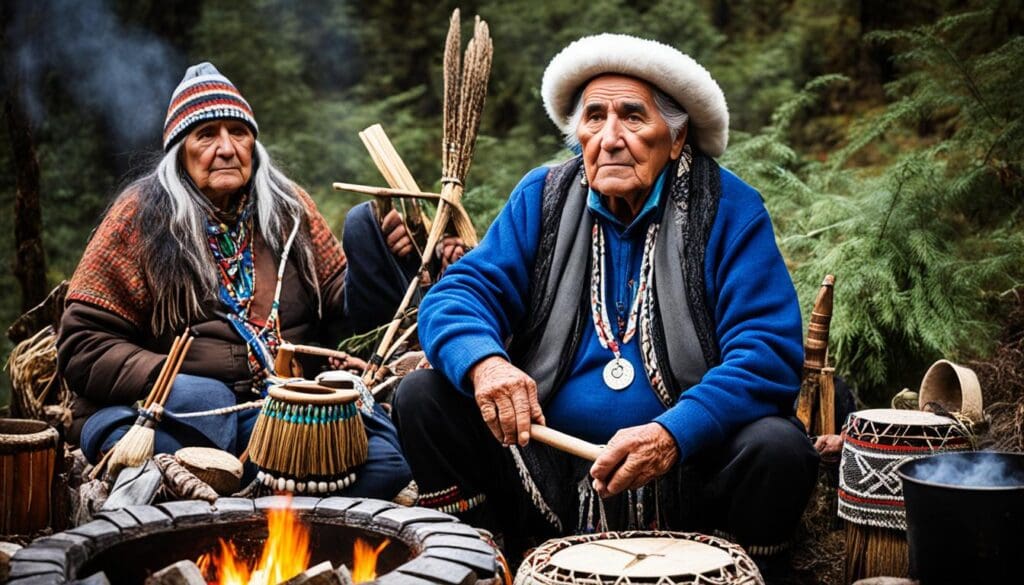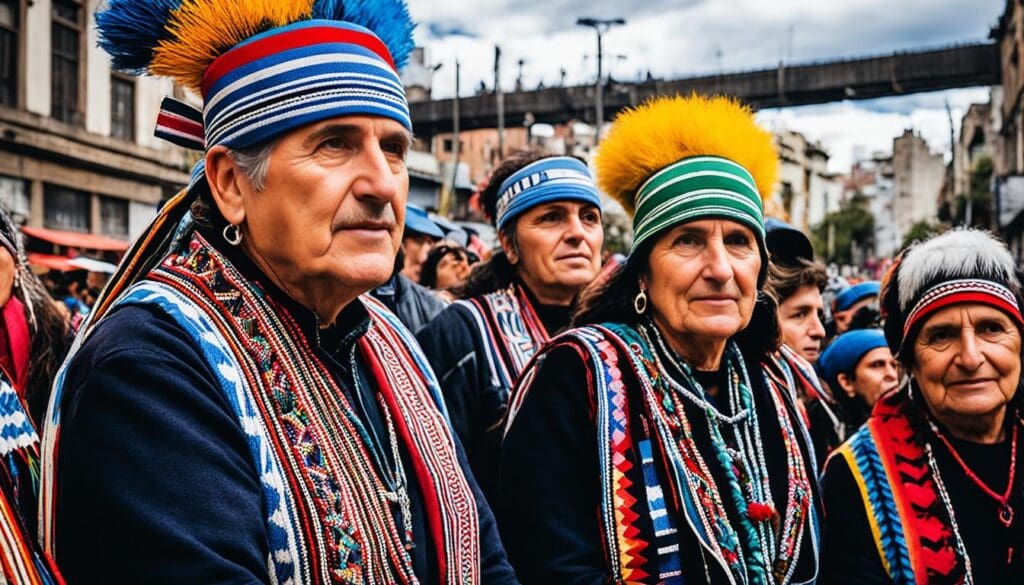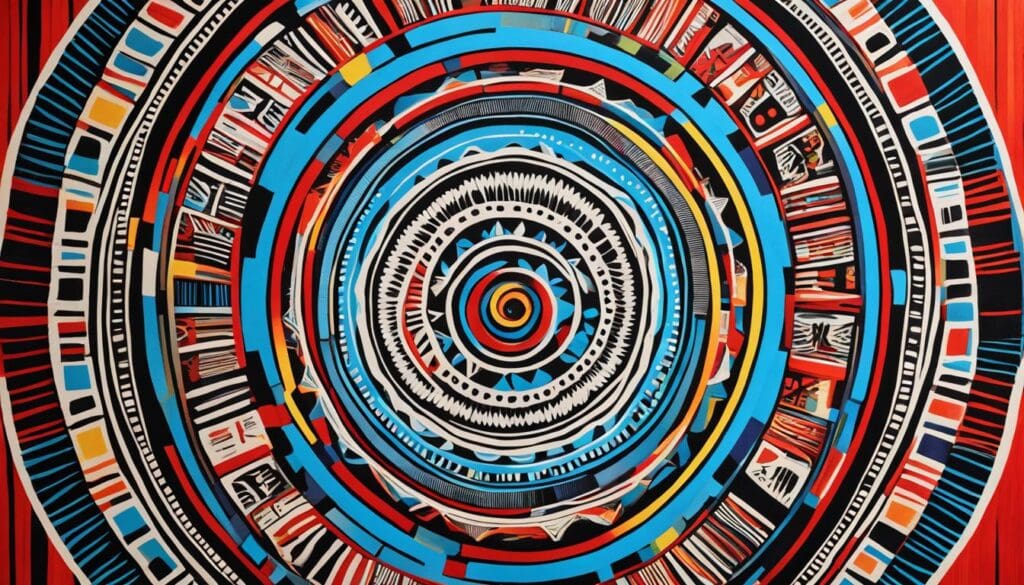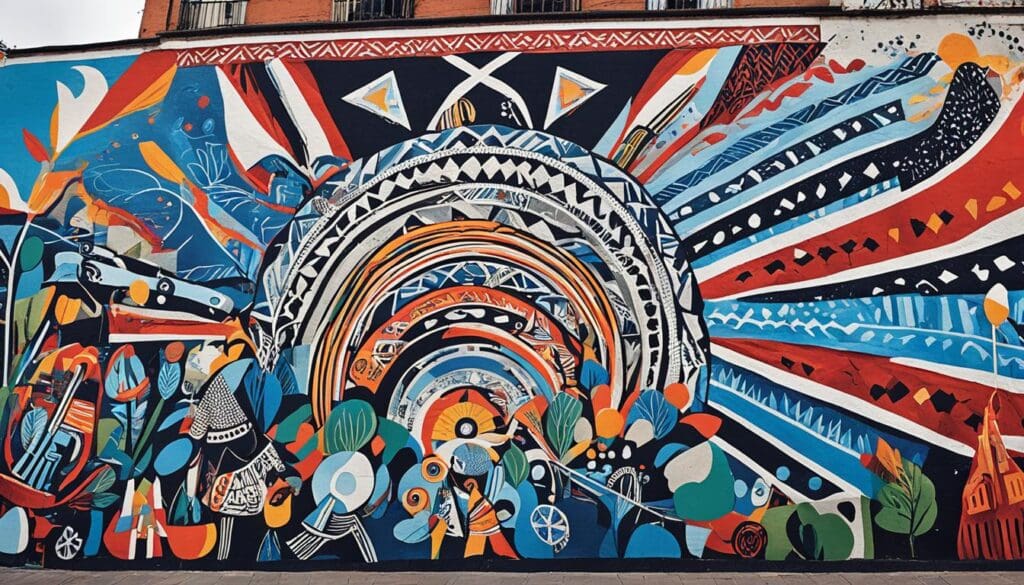

Maria Olson
At VAMOS Academy, I craft stories sprinkled with my love for exploration and food. Whether it’s the tang of a local dish or the rhythm of a new dialect, I bring these experiences to you. Ready for an adventure that tickles your taste buds and ignites your wanderlust? Let’s embark on this journey together, one story and one bite at a time.
Table of Contents
- The Influence of Mapuche Art and Crafts
- Mapuche Beliefs and Customs in Buenos Aires
- Mapuche Language and its Presence in Buenos Aires
- Mapuche Community in Buenos Aires
- Historical Influences on Mapuche Culture in Buenos Aires
- Contemporary Mapuche Art and Artists in Buenos Aires
- Mapuche Culinary Traditions in Buenos Aires
- Promoting Cultural Exchange and Appreciation
In this article, we will delve into the cultural exchanges and influences between the Mapuche people and Buenos Aires, unearthing the captivating art, customs, traditions, and community dynamics that have left an indelible mark on the city.
The Influence of Mapuche Art and Crafts
Mapuche art and crafts play a significant role in the preservation and expression of Indigenous culture. Through intricate textiles, pottery, vibrant masks, and exquisite jewelry, the Mapuche people showcase their remarkable craftsmanship and skills. These artistic forms serve as a means of passing down their cultural heritage to future generations, allowing them to stay connected to their roots and keep their traditions alive.
Vising Argentina? Start your Spanish Immersion Program in Buenos Aires Today
Mapuche textiles are known for their intricate designs and vibrant colors, reflecting the rich symbolism and storytelling of the community. Whether it’s the traditional ponchos, woven blankets, or intricately patterned fabrics, each piece tells a unique story and carries the essence of Mapuche culture.
Looking for a Study Visa in Argentina? VAMOS Academy can secure it. Start Today
Another important form of Mapuche art is their exceptional pottery. The Mapuche are renowned for their skill in creating beautifully crafted vessels and ceramics, using traditional techniques and patterns passed down through generations. These pottery pieces often depict spiritual symbols, animals, and geometric patterns, representing the interconnectedness between the Mapuche people and their environment.
In addition to textiles and pottery, the Mapuche people also create stunning masks that are used during ceremonial and cultural events. These masks, adorned with intricate designs and vibrant colors, help bring ancestral stories to life and play a crucial role in celebrating and preserving Mapuche traditions.
The art of jewelry-making is yet another remarkable expression of Mapuche craftsmanship. Mapuche jewelry is characterized by its intricate silverwork, incorporating symbols and motifs inspired by nature and spiritual beliefs. Silver necklaces, bracelets, and earrings are crafted with precision and passion, showcasing the Mapuche people’s deep connection with their culture.
Overall, Mapuche art and crafts not only serve as cultural expressions but also as a way to foster pride and identity for the Indigenous community. Through their creativity and artistic skills, the Mapuche people continue to contribute to the diverse and vibrant artistic landscape of Buenos Aires.
| Art Form | Description |
|---|---|
| Textiles | Intricate designs and vibrant colors reflecting Mapuche symbolism and storytelling. |
| Pottery | Beautifully crafted vessels and ceramics, depicting spiritual symbols and geometric patterns. |
| Masks | Intricate designs and vibrant colors, used during ceremonial and cultural events to bring ancestral stories to life. |
| Jewelry | Precisely crafted silverwork incorporating nature-inspired symbols and motifs. |
Mapuche Beliefs and Customs in Buenos Aires
The Mapuche people have a deep-rooted cultural heritage that encompasses a rich set of beliefs and customs, passed down through generations. These indigenous traditions and cultural practices have left an indelible mark on Buenos Aires, shaping its unique cultural fabric.
Central to Mapuche beliefs is a profound connection with nature and the spiritual world. The Mapuche people perceive the natural environment as a source of wisdom, guidance, and protection. Their customs, ceremonies, and rituals reflect this reverence, serving as a means to establish harmony and balance with their surroundings.
One prominent Mapuche belief is the concept of “Ñamku,” which represents spiritual guidance and wisdom from ancestors and the natural elements. In Buenos Aires, Mapuche customs often revolve around the celebration of traditional festivals and rituals that honor these ancestral connections.
These festivals and rituals offer the Mapuche people an opportunity to express gratitude, seek blessings, and reaffirm their cultural identity. Some key ceremonies include the “Nguillatun,” a communal ritual to communicate with spiritual entities and seek healing, and the “Machitun,” a ceremony to celebrate life and renew ancestral connections.
Mapuche Ceremonies in Buenos Aires
- Nguillatun: This sacred ceremony involves music, dance, and prayer, conducted in a “Ruka,” a traditional Mapuche dwelling. It serves as a unifying experience for the community, fostering a sense of belonging and reinforcing their cultural practices.
- Machitun: The Machitun ceremony celebrates the interconnectedness between humans and nature, expressing gratitude for life’s blessings. It involves the burning of traditional herbs, such as Copihue, to purify and strengthen the spiritual connection.
- Rehue: The Rehue ceremony is a ritual performed to bless important events, such as weddings and births, seeking the protection and guidance of Mapuche spirits and ancestors.
Mapuche customs also encompass the creation of intricate crafts and artwork, which serve as expressions of their cultural identity and beliefs. These artistic traditions, ranging from intricate textiles to pottery and jewelry, showcase the Mapuche people’s craftsmanship and creativity.


The preservation and celebration of Mapuche beliefs and customs in Buenos Aires not only contribute to the cultural diversity of the city but also promote intercultural understanding and appreciation. Through the continuation of these traditions, the Mapuche people ensure the legacy of their ancestral wisdom and strengthen their cultural identity in an urban context.
Mapuche Language and its Presence in Buenos Aires
The Mapuche language, known as Mapudungun, is an integral part of the Indigenous culture in Buenos Aires. While Spanish is the dominant language in the city, efforts are being made to preserve and promote Mapudungun in order to maintain linguistic diversity and honor the cultural heritage of the Mapuche people.
Mapudungun is a unique language that holds historical and cultural significance. It is spoken by the Mapuche community, who are indigenous to the southern regions of Chile and Argentina. The language serves as a means of communication and cultural expression, reflecting the deep connection between the Mapuche people and their ancestral land.
In Buenos Aires, there are initiatives aimed at revitalizing and preserving the Mapuche language. Organizations and cultural centers offer language classes and workshops to community members and the wider public. These efforts are crucial in ensuring the language survives and thrives, fostering a sense of pride and identity among the Mapuche community.
Preserving the Mapuche language not only contributes to linguistic diversity but also provides insights into the rich cultural heritage of the Indigenous people. It allows for the transmission of traditional knowledge, stories, and cultural practices from one generation to another.
Importance of Language Preservation
Language preservation plays a vital role in sustaining Indigenous cultures and promoting understanding and respect for diverse linguistic traditions. The loss of Indigenous languages would result in the disappearance of unique ways of thinking, perceiving the world, and articulating cultural concepts.
- Preserving Indigenous languages contributes to the overall linguistic diversity of a region.
- It ensures the transmission of cultural knowledge and traditions.
- Language preservation fosters a sense of identity and pride among Indigenous communities.
- It promotes respect, understanding, and appreciation for Indigenous cultures.
Efforts to preserve the Mapuche language in Buenos Aires are not only beneficial for the Mapuche community but also for society as a whole. By embracing linguistic diversity, we create a more inclusive and culturally enriched environment.
Example Mapuche Words and Phrases
| English | Mapudungun |
|---|---|
| Hello | Mari mari |
| Thank you | Ñuqueche |
| Goodbye | Pewma |
| Nature | Küme felen |
| Family | Pewü |
Exploring and preserving the Mapuche language in Buenos Aires is a crucial step in valuing linguistic diversity and sustaining Indigenous cultures. By embracing and engaging with the Mapuche language, we can deepen our understanding of the cultural heritage of the Mapuche people and contribute to a more inclusive society.
Mapuche Community in Buenos Aires
The Mapuche community in Buenos Aires plays a vital role in preserving and promoting their cultural heritage. Despite living in an urban environment, the community remains dedicated to maintaining its Indigenous identity and fostering a sense of belonging.
To support their cultural preservation efforts, the Mapuche community has established various cultural centers, organizations, and events throughout Buenos Aires. These spaces serve as platforms to celebrate and showcase Mapuche traditions, language, and customs. They provide opportunities for the community members to come together, share their experiences, and pass down their rich cultural heritage to younger generations.
One such prominent cultural center is the Mapuche Community Center, located in the heart of Buenos Aires. The center hosts workshops, exhibitions, and performances that highlight the beauty and significance of Mapuche art, music, and dance. It serves as a vibrant hub for cultural exchange and education, not only for the Mapuche community but also for the wider Buenos Aires population.
Additionally, the Mapuche community actively engages in outreach initiatives to raise awareness about their cultural identity. They organize public lectures, participate in cultural festivals, and collaborate with educational institutions to promote a greater understanding and appreciation of Indigenous traditions. Through these efforts, the Mapuche community aims to foster respect and recognition for their cultural heritage among the diverse communities of Buenos Aires.
Challenges and Community Dynamics
Living in an urban environment presents unique challenges for the Mapuche community in Buenos Aires. The fast-paced city life often creates a disconnection from their ancestral lands and traditional ways of life. However, the community’s resilience and determination have enabled them to adapt and find innovative ways to maintain their cultural identity.
Community members actively participate in cultural events and gatherings, ensuring that traditional practices and customs continue to thrive within the urban landscape of Buenos Aires. They use modern communication platforms and social media to connect with fellow Mapuche people, share information, and create networks of support.
Despite the challenges, the Mapuche community’s strong sense of cultural pride and unity help them navigate the complexities of urban living. Their unwavering commitment to preserving their cultural heritage serves as a source of inspiration not only for the Mapuche people but for other Indigenous communities and cultural groups in Buenos Aires.


Through their cultural centers, community organizations, and ongoing efforts, the Mapuche community in Buenos Aires continues to contribute to the diversity and vibrancy of the city’s cultural landscape. Their unwavering dedication to preserving their cultural identity and promoting understanding and appreciation among the wider community is a testament to their resilience and the significance of Indigenous culture in the heart of Buenos Aires.
Historical Influences on Mapuche Culture in Buenos Aires
The Mapuche culture in Buenos Aires has been shaped by a series of historical influences that have significantly impacted the community and its traditions. Understanding these historical factors is essential in order to appreciate the resilience and perseverance of the Mapuche people.
The Colonial Era: Displacement and Marginalization
During the colonial era, the Mapuche people faced displacement and marginalization as European colonizers arrived in the region. The arrival of Spanish explorers and subsequent colonization led to land appropriation, forced labor, and the suppression of Indigenous cultures. The Mapuche people, known for their fierce resistance, fought against the Spanish and successfully maintained their cultural identity, although it was significantly impacted by the colonial presence.
Cultural Assimilation: Adoption and Adaptation
As Buenos Aires developed into a thriving city, the Mapuche people faced cultural assimilation and the adoption of European customs. In order to navigate the changing social landscape, the Mapuche community adapted to new economic systems, religious practices, and language. This assimilation played a role in preserving Mapuche cultural heritage, while also integrating aspects of European influence.
Resistance and Revitalization
Despite the challenges posed by historical influences, the Mapuche people have continuously resisted cultural assimilation and worked towards revitalizing their traditions. Today, the Mapuche community in Buenos Aires actively engages in cultural events, language preservation initiatives, and artistic expressions that showcase their unique heritage and promote cultural awareness.
| Historical Influences | Impact |
|---|---|
| Colonial era | Displacement, forced labor, suppression of indigenous cultures |
| Cultural assimilation | Adoption of European customs, integration of European influence |
| Resistance and revitalization | Preservation of traditions, cultural awareness initiatives |
Despite the challenges faced throughout history, the Mapuche culture in Buenos Aires remains resilient, embracing its rich heritage while adapting to a changing world. The Mapuche people’s determination to preserve their traditions and promote cultural awareness is a testament to their enduring spirit and the ongoing importance of their cultural contributions in shaping the vibrant fabric of Buenos Aires.
Contemporary Mapuche Art and Artists in Buenos Aires
In contemporary Buenos Aires, a thriving community of Mapuche artists is making a significant impact on the city’s cultural landscape. These Indigenous artists utilize various mediums to express their rich cultural identity and challenge societal norms. Through their artwork, they delve into profound themes such as identity, social justice, and the struggles faced by Indigenous communities.
The art created by these Mapuche artists serves as a powerful medium for cultural representation and the preservation of Mapuche heritage. Their works not only showcase their artistic talent but also shed light on the diverse experiences and perspectives of Indigenous peoples. Through creative expression, these artists bring visibility to the Mapuche culture and contribute to a more inclusive and diverse arts scene in Buenos Aires.
By exploring the contemporary Mapuche art scene in Buenos Aires, we can gain a deeper understanding of the intersections between art, culture, and activism. These artistic expressions challenge the dominant narratives, giving voice to the marginalized and promoting dialogue about cultural representation.
Exploring Mapuche Artists and Their Contributions
Below, we highlight a few notable Mapuche artists in Buenos Aires and their significant contributions:
1. María Molina


María Molina is a renowned Mapuche artist known for her vibrant and visually striking artworks. Her paintings often depict scenes from Mapuche folklore, weaving together traditional symbols with contemporary artistic styles. Through her art, Maria Molina brings attention to the rich cultural heritage of the Mapuche people and the challenges they face in modern society.
2. Jorge Calfunao
Artwork by Jorge Calfunao
Jorge Calfunao is a talented Mapuche artist whose sculptures and installations explore themes of cultural identity and colonialism. His thought-provoking artworks provoke conversations about the ongoing struggles faced by Indigenous communities and the importance of preserving their heritage. Through his art, Calfunao aims to foster empathy and understanding while challenging societal norms.
3. Domingo Paillacar
Artwork by Domingo Paillacar
Domingo Paillacar is a Mapuche textile artist who incorporates traditional weaving techniques into his contemporary art pieces. His intricate textiles are a testament to the Mapuche people’s longstanding craftsmanship and their deep connection to the land. Paillacar’s art serves as a bridge between past and present, showcasing the ongoing cultural expressions of the Mapuche community.
These are just a few examples of the diverse and talented Mapuche artists making their mark on the contemporary art scene in Buenos Aires. Their works offer unique perspectives and narratives that challenge and enrich our understanding of art, culture, and society.
Mapuche Culinary Traditions in Buenos Aires
The Mapuche culture is not only showcased through art, language, and customs but also through its rich culinary traditions. Traditional Mapuche dishes have influenced and become an integral part of the gastronomic heritage of Buenos Aires. These dishes reflect the deep connection between the Mapuche people and the land, utilizing local ingredients and techniques that have been passed down through generations.
Mapuche cuisine embodies the essence of Indigenous cuisine, characterized by its simplicity, use of natural ingredients, and honoring traditional food preparation methods. This culinary heritage is deeply rooted in the Mapuche people’s close relationship with nature and their sustainable farming practices.
One of the most iconic Mapuche dishes is “curanto,” a traditional feast prepared with ingredients such as meat, potatoes, corn, and seafood. The ingredients are layered in a hole dug in the ground, covered with leaves, and cooked over hot stones. This cooking technique imparts a unique smoky flavor to the dish, making it a true sensory delight.
Another staple in Mapuche cuisine is “muday,” a hearty stew made with various ingredients like lamb, beef, or chicken, combined with potatoes, vegetables, and aromatic herbs. This dish showcases the Mapuche people’s skill in combining flavors and creating a harmonious blend of ingredients.
Mapuche Culinary Traditions Table:
| Dish | Description |
|---|---|
| Curanto | A traditional feast cooked underground with a variety of meats, potatoes, corn, and seafood. |
| Muday | A hearty stew made with lamb, beef, or chicken, combined with potatoes, vegetables, and aromatic herbs. |
| Tortillas de rescoldo | Flatbread made from flour or cornmeal and cooked directly on hot coals. |
| Ukuku | A sweet dish made from squash, honey, and spices, often served as a dessert. |
Mapuche culinary traditions extend beyond these exemplary dishes, with a wide variety of food that showcases their knowledge of local ingredients and innovative cooking techniques. From traditional breads like “tortillas de rescoldo,” cooked on hot coals, to sweet delicacies like “ukuku,” a dish made from squash, honey, and spices, Mapuche cuisine is a true reflection of their rich cultural heritage.
Indigenous cuisine in Buenos Aires not only enriches the city’s culinary scene but also serves as a platform for preserving cultural identity and promoting awareness of Indigenous traditions. It allows locals and visitors alike to experience the flavors and gastronomic traditions that have been cherished by the Mapuche people for generations.
Promoting Cultural Exchange and Appreciation
Creating meaningful cultural exchanges and fostering Indigenous awareness are crucial steps in promoting a greater appreciation for the diversity and contributions of the Mapuche people to the cultural landscape of Buenos Aires. By engaging in cultural exchange programs, both locals and visitors can gain a deeper understanding of the Mapuche culture, its customs, and its rich history.
Cultural education initiatives play a vital role in bridging the gap between different communities and promoting inclusivity. By providing opportunities for individuals to learn about Indigenous traditions, beliefs, and practices, we can foster a deep sense of respect and understanding towards the Mapuche people.
Appreciation of diversity is key to building a harmonious and inclusive society. Embracing the richness of different cultures, including the Mapuche culture, contributes to the fabric of Buenos Aires. Through art exhibitions, cultural events, and festivals, we can celebrate the Mapuche heritage and encourage others to appreciate the beauty and significance of their artistic expressions, culinary traditions, and spiritual beliefs.
Ultimately, by actively promoting cultural exchange, Indigenous awareness, cultural education, and appreciation of diversity, we can create a more inclusive and culturally-rich Buenos Aires, where the Mapuche and the wider community can thrive together, sharing in the celebration of our collective heritage.
Hey there! I’m Maria Olson, your go-to nomad with a suitcase in one hand and a pen in the other, forever caught in the dance of Buenos Aires’ energy and Malaga’s serene vibes. My life’s an open book of travels, stitched together by the countless cultures I’ve embraced and the languages that now flow from my tongue as easily as my native speech. Speaking Spanish, English, French, German, and Russian isn’t just a party trick; it’s my way of unlocking the world’s secrets, one conversation at a time.
But let’s talk about the real spice of life—food. My adventures are nothing without the flavors I’ve savored and the culinary treasures I’ve unearthed along the way. Whether it’s diving into Argentina’s vibrant markets or sipping on sangria in a hidden corner of Spain, I bring these experiences to the table, sharing a slice of the world through my tales.
Crafting blogs for VAMOS Academy, I blend my wanderlust with a dash of creativity to serve up content that’s as unique as the journeys that inspired them. So, if you’re itching for adventure, hungry for a taste of the unknown, or simply curious about the art of language, you’re in good company.




